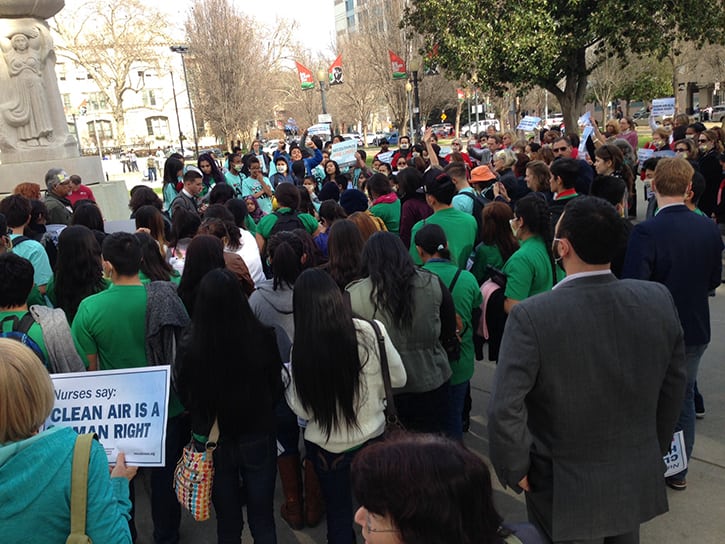Activists Show Up in Droves for EPA Ozone Hearing
The Byron Sher Auditorium in Sacramento, Calif., was filled at times with students, parents, and other concerned citizens as the Environmental Protection Agency (EPA) held the last of three public hearings on proposed updates to the national air quality standards for ground-level ozone on Feb. 2.
The hearings were scheduled as part of the policymaking process after the EPA proposed updating both the primary (health) and secondary (public welfare) ozone standards on Nov. 25, 2014. The new 8-hour standards are proposed to be set within a range of 65 ppb to 70 ppb. The EPA is also seeking comment on levels as low as 60 ppb for the health standard. The hearing in Sacramento followed hearings last week in Arlington, Texas, and Washington, D.C.
Steve Page, director of the EPA Office of Air Quality Planning and Standards, opened the session by providing some background on the proposed updates. Page noted that the proposed standards do not establish emission control requirements for any particular industry.
“Each state, as needed, will determine how to best meet the standard in a way that makes the most sense for that area,” Page said.
Attendees at the public hearing were afforded five minutes to give comments. Speakers included representatives from various industry groups, including the American Petroleum Institute, American Forest & Paper Association, Nevada Mining Association, American Chemistry Council (ACC), Western States Petroleum Association, and the California Manufacturers & Technology Association. But the vast majority of comments came from students, parents, and representatives of environmental groups, such as the Sierra Club and the Environmental Defense Fund, some loading on buses to make the trip from Southern California as early as 1 a.m.
As expected, industry groups opposed reducing the limits, while individuals and environmentalists generally supported the reduction. Members of the latter group spilled over into a park (Figure 1) across the street from the auditorium to demonstrate publicly at 1 p.m.
 |
| 1. Elementary school students, parents, and members of the California Nurses Association rally in Cesar Chavez Plaza Park, Sacramento, Calif. Source: POWER |
While asthma and other health issues associated with smog were the main reasons proponents cited for their support in reducing the limit, several of the industry representatives suggested that cuts should not be made until the current standard is met.
“Currently, 222 counties covering a population of over 120 million people are classified in non-attainment with the 75 parts per billion standard. If EPA revises the standard to the lower end of the proposed range, we estimate that more than 2,000 counties—both urban and rural—would be in non-attainment based on modeling and current monitoring data,” said Lindsay Stovall speaking on behalf of the ACC.
At least a couple of groups are worried about the proposed standards’ implications on forest management practices. Representatives from the Central Coast Rx Fire Council and the Southern Sierra Prescribed Fire Council (SSPFC) aired their concerns during the hearing.
“There are many ecosystems that are fire dependent where it may become difficult to use fire under the changes that are proposed,” said Karina Silvas-Bellanca, fire policy coordinator with Sierra Forest Legacy, speaking on behalf of SSPFC. She noted that fire is used to manage fuel loading, maintain plant and wildlife habitat quality, sustain the forest, and provide increased safety for humans.
Yolla Hager, president of Hager Environmental & Atmospheric Technologies, said that she supports lowering the standards, believing that it will encourage development of new technologies.
“I sit before you in support of lowering the ozone standard and ask you that you show the same confidence President Obama has shown in the ability of the technological entrepreneurs and innovators to help lead the way,” Hager said.
The EPA says its proposal will expand the ozone-monitoring season for many states, and update the Air Quality Index to ensure people are notified when air quality is unhealthy. Since 1980, national average ozone levels have decreased 33%. But by the EPA’s own estimates, the cost is not insignificant.
To reach a standard of 70 ppb, the EPA says it will cost $3.9 billion, and to reach 65 ppb it could cost $15 billion. Benefits are said to outweigh the costs, though, with fewer premature deaths, days of missed work and school, emergency room visits, asthma attacks, and bronchitis cases.
The EPA will accept written public comments until Mar. 17, 2015.
—Aaron Larson, associate editor (@AaronL_Power, @POWERmagazine)